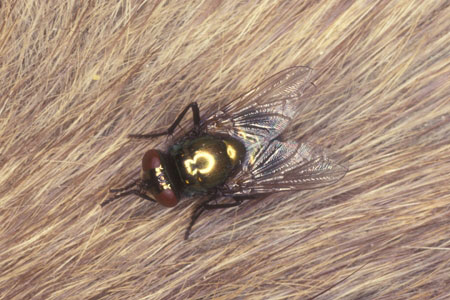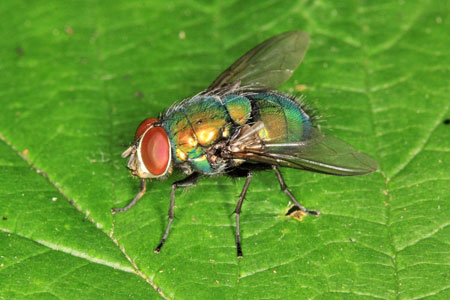Active Seasons




Green Bottle Fly Appearance and Size Facts
Also known as green blow flies, the green bottle fly is a common species slightly larger than house flies. Their wings are transparent with light brown veins, and their legs and antennae are black. They showcase a brilliant green coloration with black markings.
Some species of green bottle flies show shades of blue, gold, or black. In addition to their distinctive appearance and modest size, these flies are frequently found around dumpsters as they prefer to lay eggs in dead or decaying flesh, such as rodent, lizard or other wildlife carcass.
Identifying Green Bottle Flies From Other Flies
Unlike other fly species, the green bottle fly has a unique combination of metallic colors, wing structure, and size, making it easy to spot. Their size ranges from 1/4 to 3/8 inches, which also helps differentiate them from other flies.
We provide fly control for green bottle flies in the following locations and their surrounding areas:

Behavior and Habitat of Green Bottle Flies
As scavengers, green bottle flies play an important role in breaking down organic matter. Most commonly found near garbage, these pests are often the first insect to arrive at a carcass as they lay eggs in decomposing matter. Forensic entomologists will often use maggots from green bottle flies to determine time of death and treat wounds that won’t heal in humans.
After hatching, the larvae spend up to three days eating decomposing animal matter. They reach maturity within two to 10 days and pupate in the soil. Once they’re adults, they mate and keep going. In cold weather, pupae and adults can hibernate until warmer temperatures return.

Signs of Infestation of Green Bottle Flies
Green bottle flies and their larvae are the most common signs of an infestation. Wounds, carcasses, or rotting food are familiar places to find green bottle fly eggs, which look like small white ovals. Pale-colored maggots with distinctive shapes and movements also indicate an infestation. Additionally, a strong, putrid odor and increased fly activity indoors or near food sources could indicate a green bottle fly infestation.

Tips for Prevention of Green Bottle Flies
To keep green bottle flies at bay by eliminating their breeding and food sources, like decaying meat and vegetables. Keep outdoor spaces free of rotting organic matter and seal garbage bins regularly. Keep surfaces sanitized, store food properly, and clean up spills and debris promptly. Lastly, ensure your windows and doors aren’t cracked, open, or have damaged screens to keep green bottle flies out. Rodent baiting and trapping, rodent prevention, and rodent exclusion can also all help prevent blow fly or flesh fly infestations by reducing the chances of rodents in your home.
Getting Rid of Green Bottle Flies
If you want a clean and pest-free environment, you’ll need to know how to eliminate green bottle flies. Proper disposal of waste and tightly sealed garbage bins will eliminate the food source for the flies. Regularly emptying trash cans will prevent them from breeding, but if the problem gets out of hand, it’s essential to contact a professional pest control service like Hulett.
Effective Green Bottle Fly Control Solutions
Are you looking for effective green bottle fly control? Don’t worry–we’ve got you covered. Our team of pest control experts can eliminate those pesky flies with eco-friendly methods. Take action now and eliminate green bottle flies once and for all. Call us or schedule a free inspection to get rid of green bottle flies. Enjoy a fly-free space with Hulett’s effective control solutions.



